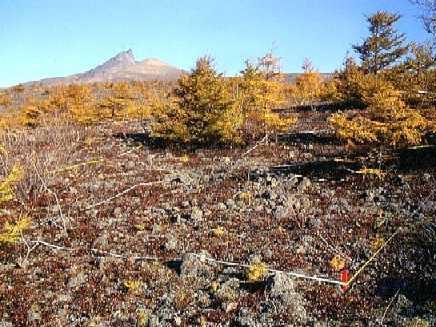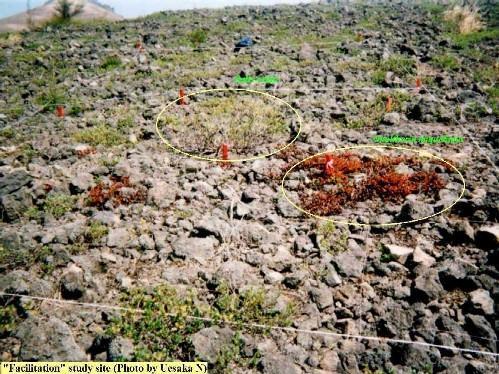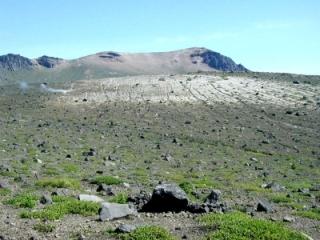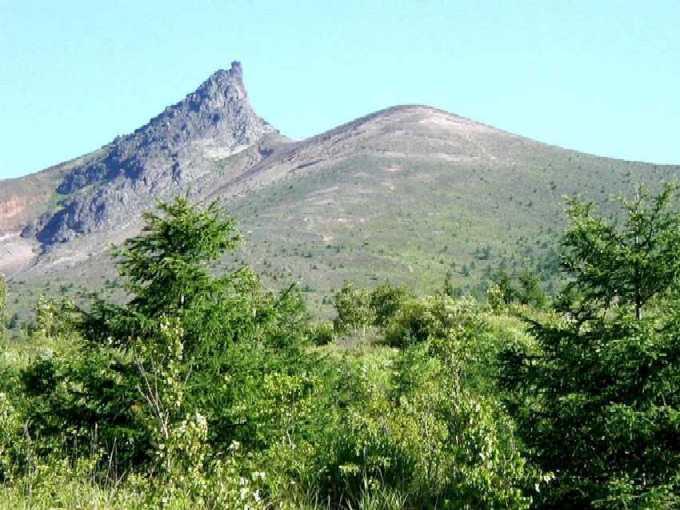(Upload on November 13 2021) [ 日本語 | English ]
Mount Usu / Sarobetsu post-mined peatland
From left: Crater basin in 1986 and 2006. Cottongrass / Daylily
HOME > Research summary > Volcanic succession > Mount Koma
| [ flora | a few wild flowers (photos) | vegetation | eruptions | references ] |
|
|
 Biological invasionMountain scaleThe 1929 eruption of Mount Koma (1140 m in altitude) completely deforested the vegetation on the summit area of the volcano. An alien species of larch, Larix kaempferi (=L. leptolepis) was planted on the lower slopes of the volcano between 1953 and 1963, but since then has become abundant on the summit. To determine the regeneration patterns of the larch, we measured stem densities on aerial photographs taken in 1963, 1973 and 1994, and in the field during 1996. Larix kaempferi stems with crown diameters > 2 m were mapped on aerial photographs divided into 1083 100 m × 100 m grids. Stem densities on the summit increased from 0.8/ha in 1963, to 14.1/ha in 1994. Willows and birches also established there but did not grow as large as the larch. All these species are wind dispersed, and larch densities were higher in areas closer to the plantations, suggesting that wind intensity and direction determined seed migration. Four environmental factors—slope gradient, direction, elevation, and distance from the plantations in each grid—were correlated with larch stem densities. Multiple regression showed that establishment patterns of L. kaempferi in the early stages were mainly related to distance from seed source (the plantations). Later, geographical disturbances and/or physiological stresses became more important. Density effects on tree invasion have been weak until now. We concluded that revegetation primarily depends on the chance of seed immigration, and that the larches may be an earlier successional species than any other native tree species (Kondo & Tsuyuzaki 1999).Habitat scale(Akasaka & Tsuyuzaki 2005) (Akasaka & Tsuyuzaki 2009) |
Between plant-plantbasically patch-forming shrub species, Salix reinii, vs cohabitantsFacilitation (定着促進効果)The effects of patches formed by a deciduous shrub (Salix reinii) and an evergreen shrub (Gaultheria miqueliana) on cohabitants were examined on an active volcano Mt. Koma, northern Japan, using bareground as a comparative baseline (control). Species richness increased with increasing the areas of three habitats (Salix patches, Gaultheria patches and bareground), but significantly slowed in Gaultheria patches where the shoot densities of cohabitants also decreased. Calamagrostis hakonensis and Spiranthes sinensis were 2–3 times more likely to establish in Salix patches than in bareground, Anaphalis margaritacea var. angustior and Campanula lasiocarpa were 4–5 times more likely to establish on bareground than in Salix patches. Cohabitants was fewer with Gaultheria. Light intensities of the two patch types were ca 1/3 of that on bareground. Light intensity on Gaultheria was ca 88% of that on Salix patch and decreased with increasing patch size, because the differences in stem and leaf architectures and phenology between the two patch-forming species. Moisture and total nitrogen in volcanic deposits were 2–3 times higher in the patches than in bareground. In the patches, low light intensity restricted seed germination, in particular, for the plants characteristic of bareground, e.g., Anaphalis, while high soil moisture increased the survival rates of Calamagrostis. In Gaultheria patches, despite high moisture, the reduced light intensity influenced seed germination and inhibited the establishment of most species. Seedbanks estimated by a lab-experiment indicated that Salix patches trapped more seeds. As a consequence, Salix patches act as facilitator, in particular, for Calamagrostis, by improving moisture and nutrients status of volcanic deposits, moderating light intensity and seed trapping. Deciduous shrub patches, such as Salix reinii, have an improving role in accelerating rates of succession in harsh environments, while evergreen shrub patches slow plant establishment (Uesaka & Tsuyuzaki 2004).Aims Shrub patches often support the colonizers particularly under stressful and/or disturbed environments. The intensities of stresses and disturbances on mountains are often related to an elevation gradient and are decreased by shrub patches (canopy and litter). We aim to clarify these relationships by using shrub patches at different elevations on a volcano. Methods We monitored all shoots in plots established inside and outside of patches of Salix reinii (Salicaceae) and their related environments, such as temperature, light, moisture and chemistry, at three elevations on Mount Koma (1131 m elevation), northern Japan, from early spring in 2005 to summer in 2006. The patch structures were evaluated by area, branch density and litter thickness. |
Important findings The structures of shrub patches did not differ among the elevations. The patches increased the diversity of rare species, by an overall increase in plant species richness. The moisture, nitrogen and phosphate contents in the patches were higher than outside of patches. The effects of shrub patches on the cohabitants were overall positive, although the effects were negative on seedling abundance, shoot survival and flowering. These results suggest that the growth patterns of shrub patches determine the plant community structures and facilitate plant diversity (Matsuda & Tsuyuzaki 2021).
 To detect the effects of a deciduous shrub Salix reinii on microclimate along a gradient of elevation during the snow-free period, we measured ground surface temperature and surface photosynthetically active radiation (PAR) for bare ground and S. reinii patches (henceforth 'patches'). Measurements were made at low (560 m above sea level), middle (665 m), and high (755 m) elevations on the Mount Koma volcano in northern Japan. Soil water content was also measured for bare ground and under S. reinii patches at the middle elevation, and wind speed was measured on bare ground at all 3 elevations. The forest canopy, dominated by Larix kaempferi, was more developed at lower elevations, and wind speeds there were lower. The PAR value in patches decreased with increasing foliage, which also reduced temperature fluctuations at all 3 elevations. The water content remained higher in patches than on bare ground. These observations show that shrub cover markedly reduces temperature fluctuation and soil desiccation by intercepting solar radiation. Differences in microclimate between the 3 elevations were less in the shrub patches, showing that the patches weakened the effects of elevation and canopy on microclimate at each of the elevations surveyed (Tsuyuzaki et al. 2012). |
| Between animal-plant | |
|---|---|
Corvus macrorhynchos vs Rhus trichocarpaThe interaction between frugivorous birds and trees producing bird-dispersed seeds in devastated areas has been considered to be weak, owing to the paucity of avifauna and/or food resources for birds. Here, we present evidence that strong interactions between birds and plants may promote the enlargement of tree distribution on harsh environments. The summit of Mount Koma, northern Japan, was denuded by the 1929 volcanic eruption. Vegetation cover gradually decreases from the bottom (secondary forest) to the top (bareground) of the mountain. We recorded 48 bird species in the four seasons of 2001, along a 5-km line transect on the southwestern slope of the mountain. Birds faeces collected along the transect contained seeds of more than 14 plant taxa. Five of the 14 taxa were bird-dispersal tree species (Rhus trichocarpa, Sorbus commixta, Prunus ssiori, Prunus maximowiczii and Prunus sargentii) and were established in the summit area. Most faeces were derived from Corvus spp. (mostly C. macrorhynchos) and Turdus naumanni. In particular, the seeds of R. trichocarpa were found mostly from the faeces of Corvus spp. and the seeds of Gaultheria miqueriana, a shrub species, were only from T. naumanni. Rhus trichocarpa retained fruits on the canopy at all times of the year, and crows could feed on them even when food resources were poor in winter. Rhus trichocarpa seedlings established well near rock at higher elevation, while they occurred mostly under the larch canopy of larches at lower elevation. Crows mostly utilized tree canopies and rocks as perches in respective habitats. Therefore, seedlings should be abundant in specific habitats at different elevations. Size-class distribution of seedlings suggested that seedling mortality was lower at higher elevation where open sites were more abundant. These findings indicate that strong mutual advantages for C. macrorhynchos and R. trichocarpa on denuded areas play an important role on revegetation (Nishi & Tsuyuzaki 2004). |
Lepus timidus ainu vs Gaultheria miquelianaAlthough seed dispersal through animal guts (endozoochory) is a process that determines plant establishment, the behaviour of carriers mean that the seeds are not always dispersed to suitable habitats for germination. The germinable seeds of Gaultheria miqueliana were stored in the pellets of a hare (Lepus timidus ainu) on Mount Koma in northern Japan. To clarify the roles of hares in seed dispersal and germination, field censuses and laboratory experiments were conducted. The field observations were conducted on pellets and seeds in four habitats (bare ground, G. miqueliana shrub patch, Salix reinii patch, and Larix kaempferi understory), and the laboratory experiments were conducted on seed germination with different light, water potential and cold stratification treatments. The laboratory experiments confirmed that seed germination began a few weeks after the sowing of seeds, independent of cold stratification, when light was sufficient and the water potential was low. The seeds did not germinate at high water potential. The pellets were gradually degraded in situ. More seeds germinated from crushed than from intact pellets. Therefore, over the long term, seeds germinated when exposed to light due to the degradation of pellets. The pellets were proportionally dispersed among the four studied habitats. More seeds sown in the field germinated more in shaded habitats, such as in the Gaultheria patch and the Larix understory, and seeds did not germinate on bare ground, where drought often occurred. Thus, the hares had two roles in the dispersal and germination of seeds: (1) the expansion of G. miqueliana populations through seed dispersal to various habitats and (2) the facilitation of delayed seed germination to avoid risks of hazards such as drought. The relationships between small mammals represented by the hare and the shrubs that produce berries are likely to be more mutually evolved than was previously thought (Nomura & Tsuyuzaki 2015). |
| Between plant-fungus | |
OverallTo investigate the role of mycorrhizae in nutrient-poor primary successional volcanic ecosystems, we surveyed mycorrhizal frequencies on the volcano Mount Koma (42°04'N, 140°42'E, 1,140 m elevation) in northern Japan. After the 1929 eruptions, plant community development started at the base of the volcano. Ammonia and nitrate levels, along with plant cover, decreased with increasing elevation, whereas phosphorus did not. In total, 305 individuals of 56 seed plant species were investigated in three elevational zones (550–600 m, 650–700 m, and 750–800 m). Five mycorrhizal classes were classified based on morphological traits: ecto- (ECM), arbuscular (AM), arbutoid, ericoid, and orchid mycorrhiza. All plant species were mycorrhizal to at least some extent, with most widespread tree species being heavily ectomycorrhizal. In addition, of 16 tree species collected in all three zones, 6 differed in the frequencies of ECM on roots between elevational zones, and 3 of these 6 species increased in frequency with increasing elevation. These results suggest that ECM colonization in some tree species is related to establishment in nutrient-poor habitats. All species of Ericaceae and Pyrolaceae had ericoid mycorrhizae, and an Orchidaceae species had orchid mycorrhizae. Herbaceous species, except for the low mycorrhizal frequency of Carex oxyandra and two Polygonaceae species, and ericoid and orchid mycorrhizal species, were generally AM. Of herbaceous species, Anaphalis margaritacea var. angustior increased AM frequency and decreased ECM frequency with increasing elevation, and Hieracium umbellatum increased ECM frequency. In total, the establishment of herbaceous species was not sufficiently explained by AM colonization on roots. Tree individuals developed 2–3 classes of mycorrhizae more than herbs at each elevational zone. We conclude that the symbiosis between seed plants and mycorrhizae, ECM in particular, greatly influences plant community structures on Mount Koma. Not only a single mycorrhizal class, but combinations of mycorrhizal classes should be studied to clarify effects on plant community dynamics (Tsuyuzaki et al. 2005). |


In the summer of 2001 by Jon Larch vs fungiRelationships involving the transfer of nitrogen (N) among Salix reinii (willow), Larix kaempferi (larch), and mycorrhizal fungi were investigated in a ridge and hillslope on the volcano Mount Koma in northern Japan using a two-pool fungal model. This model estimated N transfer among the examined taxa by measuring changes in the stable isotope ratio of N (δ15N). Although N content in tephra was low at both sites, it was higher on the ridge than on the hillslope, and higher in the willow patch than on bare ground or in the larch understory. The non-mycorrhizal sedge (Carex oxyandra) exhibited non-significant differences between the two sites regarding δ15N for N obtained from tephra. Larches developed a relationship with larch-specific Suillus mycorrhizal fungal species in the roots, and had a lower foliar δ15N on the hillslope than on the ridge. The larch δ15N increased during the growing season, while the willow δ15N remained stable. The dependence of larch on mycorrhizal fungi for N uptake was 3–5% on the ridge and 56–76% on the hillslope in autumn. Therefore, larches exhibited a flexible symbiotic relationship with mycorrhizal fungi for obtaining N. Over 45% of the N taken up by willow plants was obtained from mycorrhizal fungi at both sites. In conclusion, willow plants promoted N deposition in tephra through the litter supply, and formed a stable relationship with mycorrhizal fungi. This enabled successful revegetation with larch plants, which exhibited flexibility in terms of N uptake (i.e., dependent on mycorrhizae or from tephra) (Kwon & Tsuyuzaki 2016). |